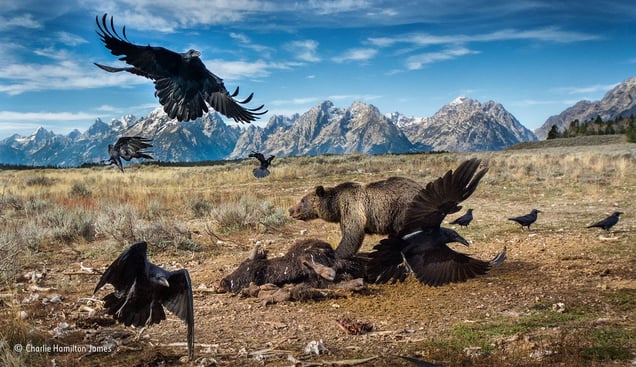Animals, abstracts, photojournalism and every imaginable natural entity in between is what makes Wildlife Photographer of the Year an annual highlight. The Natural History Museum's annual photography competition, now in its 32nd year, hosts 100 of the best images of the natural world, receives close to 50,000 entries and tours to over 60 different British cities. With these staggering statistics in mind, visiting the exhibition makes one wonder what it offers that others don't. The answer: an array of features and categories so varied even the casual viewer will struggle to leave without their eye being caught.
The sheer diversity of nature on show is immediately captivating. The exhibition is broadly broken down into competition categories, ranging from 'Earth's Environments' and 'Diversity' through to a 'Documentary' section and 'Earth's Design', the latter showing creative impressions made from expansive deserts and monochrome animal portraits. Each section carries its own weight - its own relevance to the natural world.
In 'Environments', sub-sections into under-water, urban and land convey the essence of life on Earth, collective despite its differences of habitat. Tony Wu's 'snapper party' shows a swirling shoal of fish, fins catching invading slits of sunlight. Nayan Khandkar's portrait of a leopard in urban Mumbai highlights the delicate coexistence of undomesticated species and humans. It is shots like this, so removed from scenes exposed to the general UK citizen that their insight is profound, which gives WPotY viewers their enduring fascination.
A sense of the unusual and the different carries through the exhibition, and is seen most prominently in the 'Design' section. Within this is 'impressions', where images include the highlighted silhouette of an iguana's spiky back and a 'light fandango' of fluttering mayflies. Perhaps most striking is the delicate trail of blood staining snow in Joanna Lentini's entry, 'Floe of Life', which captures the aftermath of a polar bear's attack on a seal. These confront the viewer with an impressive abstract, which needs closer inspection before the subject is determined. Elsewhere, 'Black and White Design' creates a narrative for its animal subjects, epitomised by winner Mats Andersson's 'requiem for an owl', where a pigmy owl mourns the death of its partner in chilling moonlight.
Many images are simply stunning. South African photographer Geo Cleote's image of a tussling 'tornado' of electric-blue jellyfish dazzles. Alexandre Hec's 'blast furnace' freezes exploding lava into a gel-like painting, with bright oranges and reds cast against a dark black sky. This year's grand winner - Tim Laman's 'Entwined Lives' - looks down on a climbing orang-utan from the canopy top, a mass of forest stretching out far below.
Diversity is the biggest draw for biologists, ecologists and Natural History Museum visitors, and it is certainly prominent in WPotY. The largest section - 'Earth's Diversity' - encompasses the full range of life on earth, from mammals through invertebrates to plants. Each captured in the photographer's unique way, the photos show anything from the darker reality of wildebeest migration to the luminescence of a lone and umbrella-like 'barrel' jellyfish at dusk.
But aside from the spectacular, the spellbinding, the unseen and the unusual, there remains a sincere side to WPoTY: its documentary. This section exhibits poignant reminders - through photo-series' and single image awards - of the fragile, frequently abused relationship between humans and animals. It is extremely telling that the joint winners for documentary series both told the story of a species threatened with extinction. Once the beauty of the natural world has been thoroughly celebrated and enjoyed, it seems to make the gravity and danger of species extinction only easier to realise. Whilst we are appreciative of this wonderful diversity, we are slowly showing ourselves capable of eradicating it.
Wildlife Photographer of the Year continues to be an extraordinary celebration of the natural world. Its compelling images - the result of years of photographic dedication - will inspire curiosity and awe at the breathtaking diversity and beauty of natural life. However, viewers will also leave the exhibition with a poignant reminder of how we, the human species, are the ones knowingly damaging our planet.











